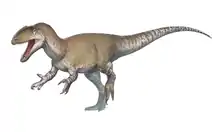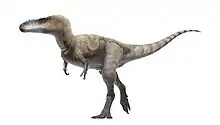| Saurophaganax | |
|---|---|
 | |
| Reconstructed skeleton at the Sam Noble Oklahoma Museum of Natural History | |
| Scientific classification | |
| Domain: | Eukaryota |
| Kingdom: | Animalia |
| Phylum: | Chordata |
| Clade: | Dinosauria |
| Clade: | Saurischia |
| Clade: | Theropoda |
| Clade: | †Allosauria |
| Family: | †Allosauridae |
| Genus: | †Saurophaganax Chure, 1995 |
| Species: | †S. maximus |
| Binomial name | |
| †Saurophaganax maximus Chure, 1995 | |
| Synonyms | |
| |
Saurophaganax ("lord of lizard-eaters"), also known as Allosaurus maximus or Saurophagus maximus, is a genus of large allosaurid dinosaur from the Morrison Formation of Late Jurassic (latest Kimmeridgian age, about 151 million years ago) Oklahoma, United States.[1] Some paleontologists consider it to be a junior synonym and species of Allosaurus (as A. maximus). Saurophaganax represents a very large Morrison allosaurid characterized by horizontal laminae at the bases of the dorsal neural spines above the transverse processes, and "meat-chopper" chevrons.[2] It was the largest terrestrial carnivore of North America during the Late Jurassic, reaching 10.5 metres (34 ft) in length and 2.7–3.8 metric tons (3.0–4.2 short tons) in body mass.
Discovery and naming
.jpg.webp)
In 1931 and 1932, John Willis Stovall uncovered remains of a large theropod near Kenton in Cimarron County, Oklahoma in layers of the late Kimmeridgian. In 1941, these were named Saurophagus maximus by Stovall in an article by journalist Grace Ernestine Ray.[3] The generic name is derived from Greek σαυρος, sauros, "lizard", φάγειν, phagein, "to eat", with the compound meaning of "lizard eater". The specific epithet maximus means "the largest" in Latin. Because the naming article did not contain a description, the name remained a nomen nudum. In 1987, Spencer George Lucas erroneously made OMNH 4666, a tibia, the lectotype, unaware that Saurophagus was a nomen nudum.[4]
Later, it was discovered that the name Saurophagus was preoccupied: in 1831, it had already been given by William Swainson to a tyrant-flycatcher, an extant eater of taxonomically true lizards.[5] In 1995, Daniel Chure named a new genus: Saurophaganax, adding Greek suffix -άναξ, anax, meaning "ruler", to the earlier name. Chure also found OMNH 4666 undiagnostic in relation to Allosaurus, so he chose OMNH 01123, a neural arch, as the holotype for Saurophaganax.[6] — and Saurophaganax is not a renaming of "Saurophagus".[7] Much of the material informally named "Saurophagus maximus", namely those diagnostic elements that could be distinguished from Allosaurus, were referred to Saurophaganax maximus by Chure. They contain disarticulated bones of at least four individuals.[7]
Saurophaganax is the official state fossil of Oklahoma,[8] and a large skeleton of Saurophaganax can be seen in the Jurassic hall in the Sam Noble Oklahoma Museum of Natural History. Although the best known Saurophaganax material was found in the panhandle of Oklahoma, possible Saurophaganax material, NMMNH P-26083, a partial skeleton including a femur, several tail vertebrae, and a hip bone, has been found in northern New Mexico.[9]
Relationship with Allosaurus
The identification of Saurophaganax is a matter of dispute. It has been described as its own genus,[7] or as a species of Allosaurus: Allosaurus maximus.[10] A review of basal tetanurans in 2004 and Carrano et al.'s comprehensive 2012 analysis of Tetanurae accepted Saurophaganax as a distinct genus.[11][12] Possible Saurophaganax material from New Mexico may clear up the status of the genus.[9]
Description

Saurophaganax was the largest carnivore found in the Morrison Formation, bigger than both its contemporaries Torvosaurus tanneri and Allosaurus fragilis, reaching 10.5 metres (34 ft) in length and 2.7–3.8 metric tons (3.0–4.2 short tons) in body mass.[13][14][15][16]
Paleoecology
The Morrison Formation is a sequence of shallow marine and alluvial sediments which, according to radiometric dating, ranges between 156.3 million years old (Ma) at its base,[17] to 146.8 million years old at the top,[18] which places it in the late Oxfordian, Kimmeridgian, and early Tithonian stages of the Late Jurassic period. This formation is interpreted as a semiarid environment with distinct wet and dry seasons. The Morrison Basin where dinosaurs lived, stretched from New Mexico to Alberta and Saskatchewan, and was formed when the precursors to the Front Range of the Rocky Mountains started pushing up to the west. The deposits from their east-facing drainage basins were carried by streams and rivers and deposited in swampy lowlands, lakes, river channels and floodplains.[19] This formation is similar in age to the Solnhofen Limestone Formation in Germany and the Tendaguru Formation in Tanzania. The fossils known of Saurophaganax (both the possible material from New Mexico and the Oklahoma material) are known from the Brushy Basin Member, which is the latest part of the Morrison Formation, suggesting that this genus was either always uncommon or that it first appeared rather late in the Jurassic. Because of the rarity of discovered remains, not much about it's behavior is known.[20]

The Morrison Formation records an environment and time dominated by gigantic sauropod dinosaurs such as Barosaurus, Apatosaurus, Brontosaurus, Camarasaurus, Diplodocus, and Brachiosaurus. Dinosaurs that lived alongside Saurophaganax, and may have served as prey, included the herbivorous ornithischians Camptosaurus, Dryosaurus, Stegosaurus, and Nanosaurus. Predators in this paleoenvironment included the theropods Torvosaurus, Ceratosaurus, Marshosaurus, Stokesosaurus, Ornitholestes, and[21] Allosaurus, which accounted for 70 to 75% of theropod specimens and was at the top trophic level of the Morrison food web.[22] Other vertebrates that shared this paleoenvironment included ray-finned fishes, frogs such as Eobatrachus, salamanders, turtles, sphenodonts, lizards, terrestrial and aquatic crocodylomorphs like Goniopholis, and several species of pterosaur like Kepodactylus. Early mammals were present in this region, such as Fruitafossor, docodonts, multituberculates, symmetrodonts, and triconodonts. The flora of the period has been revealed by fossils of green algae, fungi, mosses, horsetails, cycads, ginkgoes, and several families of conifers. Vegetation varied from river-lining forests of tree ferns, and ferns (gallery forests), to fern savannas with occasional trees such as the Araucaria-like conifer Brachyphyllum.[23] In Oklahoma, Stovall unearthed a considerable number of Apatosaurus specimens, which may have represented possible prey for a large theropod like Saurophaganax.
Bite marks on Allosaurus and Mymoorapelta remains were found among other bones with feeding traces in the Upper Jurassic Mygatt-Moore Quarry. Unlike the others, these have left striations that, when measured to determine denticle width, produced tooth and body size extrapolations greater than any known specimen of Allosaurus or Ceratosaurus, the two large predators known for osteological remains from the quarry. The extrapolations are instead coherent either with an unusually large specimen of Allosaurus, or a separate large taxon like Torvosaurus or Saurophaganax, both of which are not known from the quarry. The result either increases the known diversity of the site based on ichnological evidence alone, or represents powerful evidence of cannibalism in Allosaurus. Based on the position and nutrient value associated with the various skeletal elements with bite marks, it is predicted that while Mymoorapelta was either predated upon or scavenged shortly after death, Allosaurus was scavenged some time after death.[24]
References
- ↑ Turner, C.E. and Peterson, F., (1999). "Biostratigraphy of dinosaurs in the Upper Jurassic Morrison Formation of the Western Interior, U.S.A." Pp. 77–114 in Gillette, D.D. (ed.), Vertebrate Paleontology in Utah. Utah Geological Survey Miscellaneous Publication 99-1.
- ↑ Glut, Donald F. (1997). "Saurophagus". Dinosaurs: The Encyclopedia. Jefferson, North Carolina: McFarland & Co. pp. 793–794. ISBN 978-0-89950-917-4.
- ↑ Ray, G.E., 1941, "Big for his day", Natural History 48: 36–39
- ↑ Lucas, S.G., Mateer, N.J., Hunt, A.P., and O'Neill, F.M., 1987, "Dinosaurs, the age of the Fruitland and Kirtland Formations, and the Cretaceous-Tertiary boundary in the San Juan Basin, New Mexico", p. 35-50. In: Fassett, J.E. and Rigby, J.K., Jr. (eds.), The Cretaceous-Tertiary boundary in the San Juan and Raton Basins, New Mexico and Colorado. GSA Special Paper 209
- ↑ W. Swainson and J. Richardson, 1831, Fauna boreali-americana, or, The zoology of the northern parts of British America: containing descriptions of the objects of natural history collected on the late northern land expeditions under command of Captain Sir John Franklin, R.N. Part 2, Birds, London, J. Murray
- ↑ Chure, D., 2000, A new species of Allosaurus from the Morrison Formation of Dinosaur National Monument (Utah-Colorado) and a revision of the theropod family Allosauridae. Ph.D. dissertation, Columbia University, pp. 1–964
- 1 2 3 Chure, Daniel J. (1995). "A reassessment of the gigantic theropod Saurophagus maximus from the Morrison Formation (Upper Jurassic) of Oklahoma, USA". In A. Sun; Y. Wang (eds.). Sixth Symposium on Mesozoic Terrestrial Ecosystems and Biota, Short Papers. Beijing: China Ocean Press. pp. 103–106.
- ↑ "OK State Symbols". OkInsider.com. Oklahoma Publishing Today. 2006. Archived from the original on August 7, 2007. Retrieved December 27, 2007.
- 1 2 Foster, John (2007). Jurassic West: the Dinosaurs of the Morrison Formation and Their World. Bloomington, Indiana:Indiana University Press. p. 117.
- ↑ Smith, David K. (1998). "A morphometric analysis of Allosaurus". Journal of Vertebrate Paleontology. 18 (1): 126–142. Bibcode:1998JVPal..18..126S. doi:10.1080/02724634.1998.10011039.
- ↑ Holtz, Thomas R. Jr.; Molnar, Ralph E.; Currie, Philip J. (2004). Weishampel, David B.; Dodson, Peter; Osmólska, Halszka (eds.). The Dinosauria (2nd ed.). Berkeley: University of California Press. pp. 71–110. ISBN 978-0-520-24209-8.
- ↑ Carrano, Matthew T.; Benson, Roger B. J.; Sampson, Scott D. (June 1, 2012). "The phylogeny of Tetanurae (Dinosauria: Theropoda)". Journal of Systematic Palaeontology. 10 (2): 211–300. Bibcode:2012JSPal..10..211C. doi:10.1080/14772019.2011.630927. ISSN 1477-2019. S2CID 85354215.
- ↑ Farlow, J. O.; Coroian, D.; Currie, P.J.; Foster, J.R.; Mallon, J.C.; Therrien, F. (2022). ""Dragons" on the landscape: Modeling the abundance of large carnivorous dinosaurs of the Upper Jurassic Morrison Formation (USA) and the Upper Cretaceous Dinosaur Park Formation (Canada)". The Anatomical Record. 306 (7): 1669–1696. doi:10.1002/ar.25024. PMID 35815600.
- ↑ Paul, G. S. (2010). The Princeton Field Guide to Dinosaurs. Princeton University Press. pp. 96. ISBN 978-0-691-13720-9.
- ↑ Persons, S. W.; Currie, P. J.; Erickson, G. M. (2020). "An Older and Exceptionally Large Adult Specimen of Tyrannosaurus rex". The Anatomical Record. 303 (4): 656–672. doi:10.1002/ar.24118. ISSN 1932-8486. PMID 30897281.
- ↑ Campione, Nicolás E.; Evans, David C. (2020). "The accuracy and precision of body mass estimation in non-avian dinosaurs". Biological Reviews. 95 (6): 1759–1797. doi:10.1111/brv.12638. ISSN 1469-185X. PMID 32869488. S2CID 221404013.
- ↑ Trujillo, K.C.; Chamberlain, K.R.; Strickland, A. (2006). "Oxfordian U/Pb ages from SHRIMP analysis for the Upper Jurassic Morrison Formation of southeastern Wyoming with implications for biostratigraphic correlations". Geological Society of America Abstracts with Programs. 38 (6): 7.
- ↑ Bilbey, S.A. (1998). "Cleveland-Lloyd Dinosaur Quarry – age, stratigraphy and depositional environments". In Carpenter, K.; Chure, D.; Kirkland, J.I. (eds.). The Morrison Formation: An Interdisciplinary Study. Modern Geology 22. Taylor and Francis Group. pp. 87–120. ISSN 0026-7775.
- ↑ Russell, Dale A. (1989). An Odyssey in Time: Dinosaurs of North America. Minocqua, Wisconsin: NorthWord Press. pp. 64–70. ISBN 978-1-55971-038-1.
- ↑ Foster, J. (2020). Jurassic West, Second Edition: The Dinosaurs of the Morrison Formation and Their World (Life of the Past). Indiana University Press. ISBN 9780253051578.
- ↑ Foster, J. (2007). "Appendix." Jurassic West: The Dinosaurs of the Morrison Formation and Their World. Indiana University Press. pp. 327–329.
- ↑ Foster, John R. (2003). Paleoecological Analysis of the Vertebrate Fauna of the Morrison Formation (Upper Jurassic), Rocky Mountain Region, U.S.A. New Mexico Museum of Natural History and Science Bulletin, 23. Albuquerque, New Mexico: New Mexico Museum of Natural History and Science. p. 29.
- ↑ Carpenter, Kenneth (2006). "Biggest of the big: a critical re-evaluation of the mega-sauropod Amphicoelias fragillimus". In Foster, John R.; Lucas, Spencer G. (eds.). Paleontology and Geology of the Upper Jurassic Morrison Formation. New Mexico Museum of Natural History and Science Bulletin, 36. Albuquerque, New Mexico: New Mexico Museum of Natural History and Science. pp. 131–138.
- ↑ Drumheller, Stephanie K.; McHugh, Julia B.; Kane, Miriam; Riedel, Anja; D’Amore, Domenic C. (May 27, 2020). "High frequencies of theropod bite marks provide evidence for feeding, scavenging, and possible cannibalism in a stressed Late Jurassic ecosystem". PLOS ONE. 15 (5): e0233115. Bibcode:2020PLoSO..1533115D. doi:10.1371/journal.pone.0233115. ISSN 1932-6203. PMC 7252595. PMID 32459808.
Sources
- Dixon, Dougal. The World Encyclopedia of Dinosaurs and Prehistoric Creatures.


.jpg.webp)












